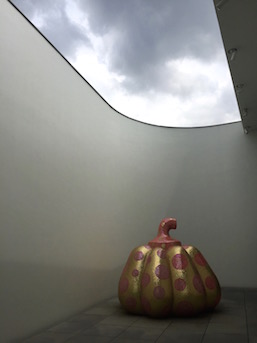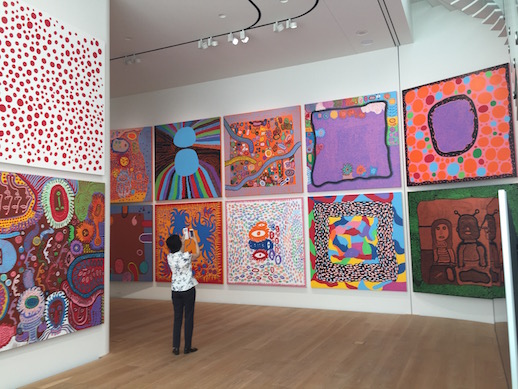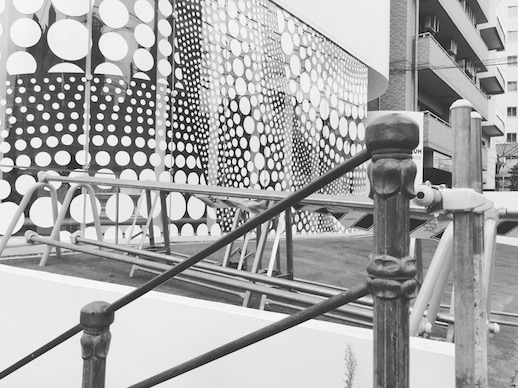Your Guide to the Yayoi Kusama Museum

The art world might as well declare 2017 as the year of Yayoi Kusama. After exhibitions throughout Japan, new work unveiled at the Honolulu Biennial, and shows touring North America and London, the queen of polka dots, peace, and love has opened the Yayoi Kusama Museum in Shinjuku, Tokyo. The new space is run by the foundation she created to manage her artwork and exhibitions even after her death. It is sure to be the hottest spot for art lovers and tourists for the next year or two. Tickets for the four daily 90-minute time slots, available for four days every week in October and November, were sold out before the museum officially opened. Tickets can be purchased online anywhere in the world without having to pay additional service fees. The inaugural exhibition “Creation is a Solitary Pursuit, Love is What Brings You Closer to Art” is a blockbuster success and will run until February 2018. Creating art might be lonely as Kusuama claims, but viewing her work is as popular as ever.
Yayoi Kusama is one of the most influential living artists to have ever have come out of Japan. She is a writer and an avant-garde artist working in almost every medium: painting, collage, soft sculpture, installation, performance, fashion, film, and environmental art. Even if you do not know her, you have most likely seen pictures of her work featuring the motifs of pumpkins or polka dots. She socialized with well-known artists such as Donald Judd, Eva Hesse, Georgia O’Keefe, and Joseph Cornell soon after she arrived in New York in the late Fifties.
Kume Sekkei was responsible for designing the new museum as stacked boxes spiraling upwards to fit in a lot smaller than 200m2. The floor finishes, ceiling heights, and window locations vary on each of the five stories. The rounded corners of the wall echo the idea of the spiral with energy, light, air, and traffic seamlessly flowing through the building. With the subtly dotted stairs near large, airy windows with adjustable shades and an atrium and large window for viewing the cityscape below, walking through the museum is an enjoyable experience, even on a muggy day. The white building blends in with the surrounding buildings, as infill structures should.

With space limited, each floor fulfills its own function. The first level has a reception desk, souvenir shop, and lockers. The second and third floors are exhibition spaces, with 27/50 black-and-white silkscreen prints of Kusama’s drawings from the Love Forever series (2004-2007) on the second level and 16 of the more than 530 colorful acrylic paintings from the ongoing series My Eternal Soul on the third. Some works are new; some have never been displayed before; some were at the National Art Center, Tokyo (NACT) in Roppongi this past summer. The fourth floor is for the mirror room, Pumpkins Screaming About Love Beyond Infinity (2017), specially made for the museum. Six people are allowed at a time in the room, but only for three minutes. This space filled with glowing, polka-dotted pumpkins seemed smaller and the patterns of dots more simplistic than some of her past mirrored rooms, such as the one at the NACT this year. Unlike past installations, this one is behind glass, probably because a selfie-taker damaged a work at a touring Kusama exhibition. The fifth floor is the atrium with a library of books about Kusama in English and Japanese, as well as the work Starry Pumpkin (2017) made for the museum. It is not one of her largest pumpkins, but it is one of the most decorated, with rosy pink and gold tiles. Starry Pumpkin under a night sky seems like an appropriate name, doesn’t it? Don’t forget the elevator! It is a larger mirror room covered in big red polka dots, providing a chance to take a selfie without harming any artwork.
Kusama highlights her belief in the wonder of life and a sense that life forces expressed in art can drive away the darkness in people’s hearts during turbulent times. Love is a common theme throughout her career, and she hopes that world peace will eventually be possible. Did she notice that her museum is near a shrine with a pole written with the words “May Peace Prevail on Earth” in several languages?

Frequently Asked Questions
Will 90 minutes be enough to enjoy everything thoroughly?
Don’t worry! This show is much smaller than her solo at the NACT, and the artwork is large enough that you should be able to see it clearly even if people are standing in front of you.
How can I buy tickets if I do not understand Japanese?
You can buy e-tickets online from the Yayoi Kusama Museum website or the etix website. Both have pages in English. Tickets for January 2018 openings will go on sale November 1!
Yayoi Kusama Museum: www.yayoikusamamuseum.jp/
Etix: www.e-tix.jp/yayoikusamamuseum/en/
If the show is sold out, how will I be able to see the art with lots of people there?
The museum staff seems prepared for the crowds. Tickets are limited, and each group has a set amount of time. If you are physically mobile, they would like your co-operation in directing the flow of traffic by going up the stairs and down in the elevator. (Yes, they will understand that someone in a wheelchair cannot take the stairs. Strollers, however, are not allowed because the space is limited.) The mirror room has a timer to ensure that each group gets three minutes and no more. With the timed reservation system, you should not have to wait hours in line like people did at the NACT.
Are any other museums nearby? I am only in Tokyo for a short time and want to see as much as I can.
The Natsume Soseki Memorial Museum dedicated to the turn of the 20th century novelist opened in September 2017 and is a short walk away. Most of the content will probably be in Japanese, but the architecture is interesting. It has a small cafe if you need a snack. You can also use the handy Tokyo Art Beat app to explore more art and cultural sites around Tokyo.
Will the explanations be only in Japanese?
The catalog and pamphlets for the inaugural exhibition are available in English and Japanese. Even some of the books in the library on the fifth floor are in English, including autobiographical writing by Kusama herself.
Can I see some of her soft sculptures from the Seventies?
The inaugural exhibition, unfortunately, only includes artwork from the 21st century. Future shows will hopefully feature work from her archives.
Michelle Zacharias
Michelle Zacharias



